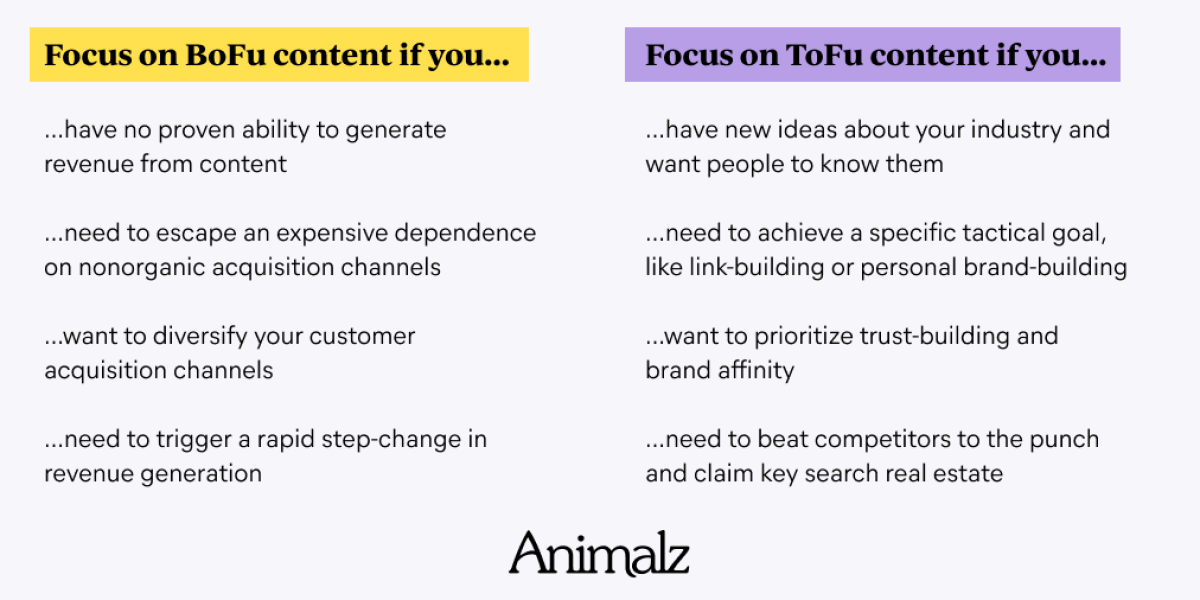I’m a big believer that the difference between “writing” and “content marketing” is revenue. Content marketing is writing that serves a business objective. It exists to make sales easier.But that doesn’t mean that every company should focus myopically on bottom-of-the-funnel content, ultra-high-intent keywords, and immediate conversions. There are lots of ways that content can influence revenue without outright converting a customer—some content will never generate a concrete ROI, but is still worth writing.The idea of opportunity cost is important here: Focusing solely on conversion content will generate immediate revenue, but it can prevent you from tackling higher leverage activities that could generate 100x that revenue in the future.
The Stanford Marshmallow Experiment
The “top-of-funnel versus bottom-of-funnel” argument always reminds me of the Stanford marshmallow experiment. In the experiment, children were offered a choice between one marshmallow, available immediately, or two marshmallows if they were willing to wait for fifteen minutes.Focusing solely on bottom-of-the-funnel content is like cramming that first marshmallow into your mouth. It’s instant gratification, and it comes at the expense of a bigger, future reward… but sometimes you just need a marshmallow right now.
Top-of-the-funnel content is like waiting for those two marshmallows. It’s delayed gratification that does little for you for those fifteen long, boring minutes, but the eventual payoff is often far larger.Don’t let anyone guilt you into believing that you’ve adopted the wrong strategy. Top of funnel versus bottom, one marshmallow or two, there is no objectively right or wrong choice. There is only the need of your business.

When to Focus on Bottom-of-the-Funnel Content
We recommend bottom-of-the-funnel content for plenty of companies, and they usually have one trait in common: They need to build an immediate and consistent revenue pathway with content. These are often companies that:
Have no proven ability to generate revenue from content. If you’ve never generated revenue from content marketing, bottom-of-the-funnel content can help test your assumptions and prove that, yes, content marketing will work for your audience and your product.
Need to escape an expensive dependence on nonorganic acquisition channels. Lots of startups use paid advertising to begin scaling their customer acquisition, but as costs increase and audiences grow more saturated, it becomes necessary to explore cheaper, compounding forms of customer acquisition.
Want to diversify their acquisition channels. Many startups generate initial growth through their network and then need to add new acquisition channels to ensure the growth continues, if and when those first few referrals begin to slow.
Need to create a step-change in revenue generation. Fundraising rounds, new leadership goals, pandemic-esque global events… plenty of extrinsic factors ignite the need for a new wave of revenue growth.
In each instance, the continued growth and success of each company really does depend on generating revenue from content marketing as quickly as possible.
Even if the same effort expended on top-of-the-funnel content could generate greater long-term results, it wouldn’t matter: Given their constraints and goals, bottom-of-the-funnel content is the right strategy to pursue. These are companies that really do need that single marshmallow.But crucially, this does not describe every company.
When to Think Bigger
Many companies already have a solid content-to-revenue pathway established. They have a proven ability to turn writing into revenue, and “reach” has become their limiting factor: They need to focus on building better customer relationships, attracting new audiences, and tapping into new markets.
Bottom-of-the-funnel content is not the best way to achieve those goals. Some common top-of-the-funnel scenarios we see are companies that:
Prioritize trust-building and brand affinity. There’s more to the conversion equation than just “serve the right content at the right time”: Companies also need to build trust in the legitimacy and provenance of their advice.
Have new ideas about their industry and want people to know them. Top-of-the-funnel content—particularly thought leadership—helps companies differentiate from their competitors, demonstrate subject-matter authority, and stand out from the noise of a crowded industry.
Need to achieve a specific tactical goal. Top-of-the-funnel content is essential for link-building, ranking #1 for specific keywords, building a team member’s personal brand, and a host of other tactical goals. Many of these will help generate revenue; others might not, but they serve to hit internal milestones and please key stakeholders—managers, executives, or investors.
Beat competitors to the punch and claim key search real estate. Many companies recognize that there’s a game theory element to content marketing: Using top-of-the-funnel content to rank for lucrative keywords and show up in thousands of SERPs can make it harder for competitors to follow suit.
For companies in the above scenarios, focusing on quick conversions with more bottom-of-the-funnel content would offer—at best—a marginal benefit. An extra sale or ten is never to be sniffed at, but those sales do little to help unlock the next phase of bigger, more impressive growth.A lot of these objectives fall under the umbrella of “brand marketing.” It’s a mistake to assume that brand is totally disconnected from revenue generation: Much of the trust-building and familiarity required for bottom-of-the-funnel content to work stems from “brand” activities.
Much of the trust-building and familiarity required for bottom-of-the-funnel content to work stems from “brand” activities.
Reject Black-and-White Claims
Every company wants to generate more revenue and convert more customers.The nuance here appears because bottom-of-the-funnel content is not always the best way to generate more revenue and customers. For some companies, the biggest future revenue opportunities will come through focusing on high-traffic, top-of-the-funnel content.Top or bottom, future traffic or immediate revenue—there is no concrete, black-and-white content marketing strategy on offer. Every company will, at some point, require both top- and bottom-of-the-funnel content. The key thing is to recognize where your greatest content opportunities lie at any given time. Sometimes, that means focusing solely on bottom-of-the-funnel content. Sometimes, it means prioritizing top-of-the-funnel.
